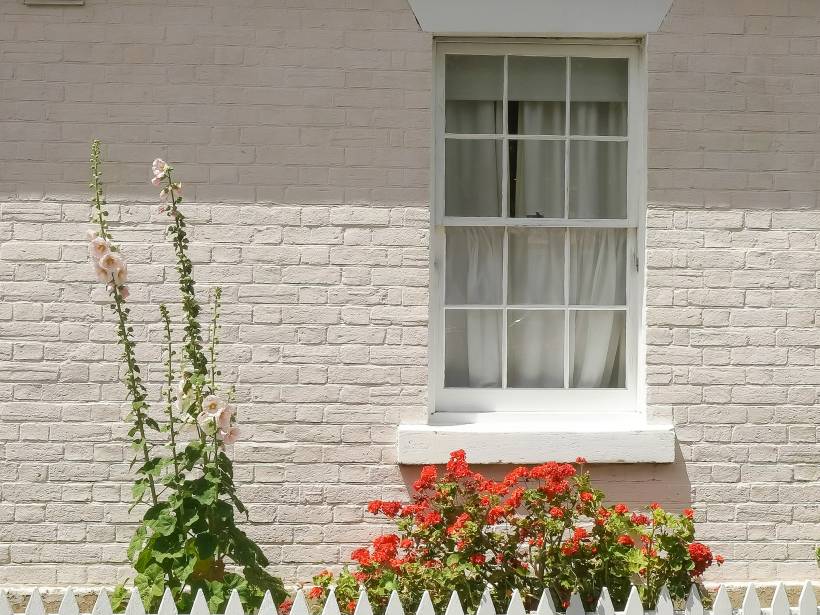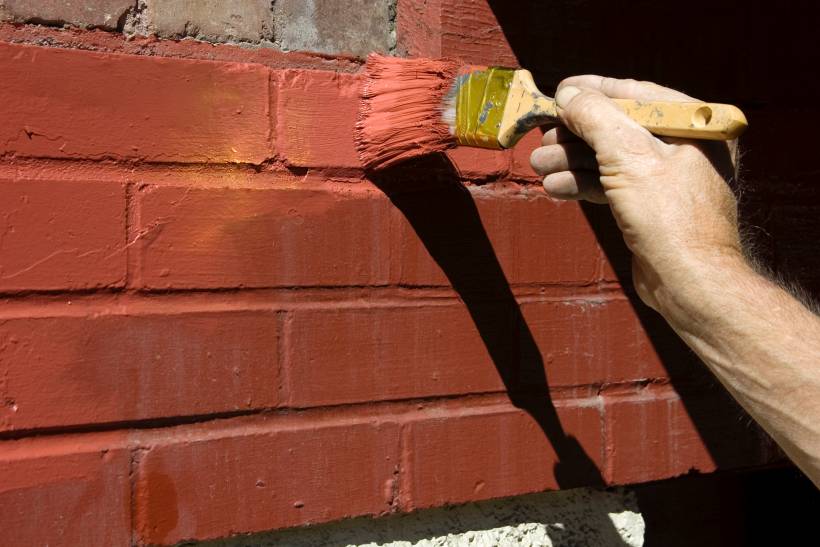| Did you know? • Bricks must be completely dry before painting; allow at least three rain-free days in the summer and up to a week in the winter for proper drying. • Paint colour affects your home’s temperature—lighter shades reflect heat while darker colours absorb it, potentially reducing the need for air conditioning by up to 20%. • Quality masonry primer is non-negotiable; it’s the most common cause of paint failure on brick surfaces. |
Brick walls give homes a timeless charm that many other surfaces can’t match. Their texture and character add warmth and depth to any house design. Over time, however, brick can appear worn or outdated as design trends shift, but the best paint for brick exterior can change all that.
According to independent studies, exterior painting projects increased property values by an average of 5%, making it one of the most cost-effective home improvements available to homeowners. In this guide, we’ll show you the best paint for an exterior brick house, helping you create a home that stands out with its beauty and character.
Why painting your exterior brick walls matters

Painting your brick walls gives your home an instant facelift while boosting its value, potentially increasing your property’s selling price. This is huge, especially if you’re trying to maximise its value before listing it on the market.
But paint does more than just make your home look good. It creates a protective shield against the worst weather and other external factors. Quality exterior coatings for painted brick homes stop moisture from seeping into your brickwork, block damaging UV rays, and prevent brick from cracking during freeze-thaw cycles (particularly in colder regions like Tasmania and parts of Victoria).
This protection helps your brick last longer while letting you put your personal stamp on your home.
Understanding exterior brick and the types of paint that work best

Brick walls aren’t like other surfaces—they breathe and move with the weather. By nature, brick is porous, which means it has thousands of tiny holes that soak up water when it rains and release it when conditions dry out. This attribute means the brick expands in hot weather and shrinks when temperatures drop.
Brick’s unique behaviour means you can’t just use any paint. Regular house paint can trap moisture inside your bricks, leading to bubbling, peeling, and even damage to the brick itself. The best breathable paint for exterior brick works with the brick’s natural properties rather than fighting against them.
Therefore, the paint you pick affects how your home looks today and how well it holds up over the next decade. Here are some common choices:
Elastodynamic paint
This high-performance coating actively adapts to brick movement and prevents cracking. Its thick, flexible layer bridges existing cracks and creates a watertight seal that stops water infiltration. Elastodynamic paint withstands extreme weather conditions and provides protection for up to 10 years due to its substantial thickness.
Best for: In Australia, the best paint for brick exterior is usually elastodynamic paint because it works well with homes subject to big temperature swings. Elastodynamic paint is also ideal for old homes.
Acrylic latex paint
This affordable option allows trapped moisture to evaporate quickly from porous brick, reducing damage from freeze-thaw cycles. You’ll typically need just one coat, making application faster and easier. While durable, acrylic latex tends to show dirt, grime, and mildew more readily than other finishes.
Best for: Many budget-conscious homeowners in milder climates consider acrylic latex the best paint for exterior brick walls, since dirt accumulation in these areas is less problematic.
Limewash paint
This centuries-old, eco-friendly formula combines crushed limestone, natural pigments, and water to create a distinctive weathered appearance. Limewash penetrates the brick rather than forming a film on top, allowing the surface to breathe naturally. A professional application delivers the best results for this specialised finish.
Best for: Heritage homes or properties where owners want an authentic, vintage aesthetic using environmentally sustainable materials.
Silicone masonry paint
Unlike standard masonry paints, silicone-enhanced formulations offer superior breathability while actively repelling water. The incorporated silicone resins keep brick surfaces completely dry without trapping moisture, contributing to exceptional durability with a potential lifespan that could last a decade or more.
Best for: Properties in high-rainfall or humid regions where moisture protection is non-negotiable but breathability must be maintained.
Enamel paint
This robust option delivers a glossy finish that resists chipping and peeling while blocking UV rays and moisture. Many manufacturers now offer high-temperature enamel formulations specifically designed for brick, ensuring they withstand extreme conditions without fading or deteriorating.
Best for: Ideal for painting a brick house, garden wall, patio, or other high-traffic exterior features where durability and a polished appearance are priorities.
Things to consider when choosing the best paint for exterior brick walls

But wait—don’t go out yet and buy the next paint you find. Consider these key factors to get the best results for your brick home (and save yourself a trip):
- Weather resistance: Australia throws everything at your home—baking sun, heavy rain, and wild temperature swings. Pick paints that can handle these conditions without peeling or fading.
- Breathability: Brick needs to ‘breathe’ so moisture doesn’t get trapped. Choose paints that let water vapour escape, or you might end up with mould and damage to your walls.
- Colour and finish: In general, lighter colours reflect heat better. For finish, satin works well for most homes; matte hides imperfections; gloss makes cleaning easier but shows flaws. For style inspiration, look at exterior paint colours for brick homes trending in your area.
- Durability: Good exterior paint should last 7 to 10 years without major problems. Check the warranty; paints with longer guarantees usually perform better.
- Brick condition: Take a good look at your walls first. Fix any cracks, chips or crumbling mortar before painting. Also check how porous your brick is by splashing some water on it. If it soaks in quickly, you’ll need a good primer and possibly more paint. For more complex repairs, consider hiring a builder.
- Paint quality: Better quality paints cost more upfront but usually last longer and cover better. Check how many square metres a litre covers and read reviews from other homeowners.
When in doubt, ask at your local paint or hardware store. Describe your specific brick type and home conditions, and they can recommend products that have worked well for similar projects.
5 best paint colours for exterior brick walls colours for brick houses
The colour you choose when painting exterior brick can dramatically transform your home’s character. Here are five outstanding options that have proven themselves in Australian homes:
1. Timeless white

Nothing beats white for versatility and kerb appeal. Besides showcasing your home’s architectural features, it’s also a canvas that lets you express your style through colourful gardens, statement doors, or dramatic lighting. Each creates a different feeling for your home and community.
2. Warm terracotta

This rich, earthy hue celebrates brick’s natural heritage and delivers that sought-after Mediterranean villa feel. Choose terracotta if you want to showcase your landscape work; it makes everything from native grasses to timber accents look deliberately chosen.
3. Contemporary grey

Grey has firmly established itself as the modern classic for exteriors. From soft pewter to dramatic charcoal, these sophisticated neutrals create a striking backdrop for metal fixtures and landscaping. Since grey falls in the middle of the brightness scale, dust and dirt don’t contrast sharply with these shades, making them less noticeable.
4. Shades of blue

Blue exterior bricks make a confident statement that could set your home apart in a big neighbourhood. Whether you fancy a breezy coastal blue or a dramatic navy, these tones create magnificent contrast against white trim.
5. Sage green

Sage’s understated, nature-inspired colour delivers a peaceful presence in any street. It visually connects your home to the surrounding nature, absorbing light rather than reflecting it.
If you’re not sure what shade to select, read our guide on how to match paint colour to your existing exterior elements. In the end, the best exterior paint for brick homes comes down to your personality and style.
Should I paint my own exterior brick walls or call a pro?

The paint-or-pay decision boils down to your skills, time, and budget. Here’s what to consider:
DIY Painting
Painting brick yourself cuts costs in half but demands serious commitment. The average home needs 3–5 full days of work for professionals, but DIYing it can take up to 4 weeks, even longer if you’re doing full-fledged home renovation. Success hinges on thorough prep: power washing, mortar repairs, and quality primer.
You also need to budget for extra paint for exterior bricks because brick drinks it up. Also, invest in good rollers, brushes, and safety equipment.
Hiring a professional
Pros bring speed, expertise, and commercial equipment that transform results. They spot hidden issues like rising damp or structural cracks before they become major problems. A standard four-bedroom brick home costs $4,500 to $13,000 to paint professionally, but this includes warranties, insurance, and peace of mind.
For heritage properties, multi-story homes, or damaged brick, professional painting work becomes essential rather than optional.
For more extensive home renovation projects, hiring professionals makes sense. They bring specialised equipment and knowledge that you’d otherwise miss, and might even add precious years to your paint job’s life.
Painting your exterior wall, brick by brick
Painting your brick exterior does two important jobs at once: it protects your walls from the sun while making your home look chef’s-kiss-fantastic. Most people underestimate how much paint choice matters for this part of the house, as excellent paint selection lets your brick breathe while keeping rain and sun damage away.
When you’re ready to give your exterior brick walls a refresh, make sure to check Oneflare to hire qualified painters who understand the nuances of working with bricks for a lasting and beautiful finish.
FAQs on exterior paint finishes
What paint do you need for brick walls?
Exterior brick should be painted with porous paint so that it can breathe. Use high-quality paint and apply a conditioner or primer first, followed by the breathable exterior paint for best results.
Do you need a primer to paint the exterior brick?
Whether you’re tackling older or newer brick, indoors or out, using a primer is a non-negotiable step for a job well done. The real trick is to ensure primer bonds with the brick, getting into all those nooks and crannies. The stronger that bond, the better your paint will stick, giving you a professional finish that lasts.
How do you prepare exterior brick for painting?
Clean the brick thoroughly with a pressure washer and allow it to dry completely (at least 24 hours). Repair any damaged mortar joints. Apply a quality masonry primer designed specifically for brick. Mask off areas you don’t want painted, including windows, doors and fixtures.
How much does it cost to paint exterior brick walls?
For DIY projects, expect to spend roughly up to $8,000 for a three-bedroom home. The costs could be much more (up to $20,000), depending on your home’s size and condition. For a detailed breakdown, see our cost guide for hiring painters.
What does ‘breathable’ paint mean?
Breathable paint allows water vapour to escape the brick while keeping liquid water out. This feature prevents moisture from becoming trapped inside the brick, which can cause damage through freezing, efflorescence (white salt deposits), or mould growth.
Where can I buy good quality exterior brick paint?
Quality masonry paints are available at hardware stores, paint specialty retailers, and home improvement centres. Look for stores with dedicated paint departments that offer expert advice on product selection for your specific brick type. Many locations also provide colour-matching services and can help you determine the right amount of paint for your project.






